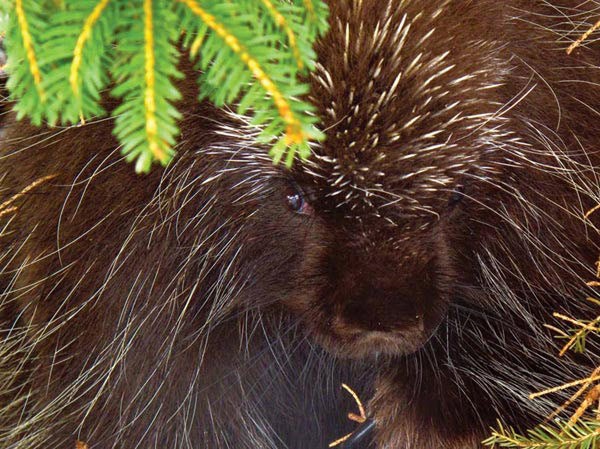The feeding habits of porcupines are far more diverse than many people realize. Cambium, phloem, foliage, buds, flowers, fruits, and nuts comprise the mainstay of Erethizon dorsatum’s diet. Spring and summer offer a much-relished salad of greens, including the flowers and new growth of a large variety of herbaceous plants.
One summer day I sat in a tree stand overlooking a small meadow and was delighted to watch a porcupine and a doe peacefully feeding within 15 yards of one another; they were eagerly consuming clover flowers and leaves. Violets, alfalfa, and milkweed flowers are known to be porcupine favorites and swimming porcupines are regularly observed harvesting water lilies and pond weed. These aquatic plants provide porcupines with sodium, calcium, and other important minerals, as do shed antlers.
The porcupine is neither nimble nor speedy, yet this big rodent is a capable climber. Stout curved claws effectively grasp bark crevices, while the porcupine’s broad naked feet, pebbled with fleshy tubercles, provide traction. The animal’s muscular tail serves as a kind of climbing prop, sometimes even as a fifth leg, and this undoubtedly enhances the ponderous porcupine’s success at defying gravity. The hallux, or big toe equivalent on the hind foot, is modified with an elongated flexible pad that enables the porcupine to grasp and even manipulate branches.
“Nip twigs” are evidence of porcupines’ nocturnal feeding within hemlocks during winter. These ¼- to 1½-inch-diameter branchlets are cut from reachable places throughout the tree. Most fall to the ground, but some (called “hangers”) conspicuously dangle from branches in the understory. Angled cut surfaces show that the branches were cleanly bitten by an animal with sharp upper and lower incisors, and not broken by black bears or storms. Remaining branches in the tree’s crown will develop a “broomed” look, exhibiting a proliferation of lateral branches that seek to compensate for the loss of terminal stems. Hemlocks that have been heavily fed upon will have dense clusters of branches in some places, and look oddly open and devoid of branches in other places. Selective removal of all accessible branches sometimes leaves only the thin-stemmed topmost branches free from herbivory. These delicate branchlets cannot possibly support the weight of a porcupine, hence they remain intact.
Beneath the hemlock, you can find nip twigs and feces. Porcupines will have consumed the new growth of needles and stems, and you can sometimes find gnawing signs on the bark of larger branches. Finally, look for this diagnostic sign that can be recognized on all rodent-chewed branches, including squirrel and beaver: The flat surface of the cut stem will be grooved with a series of incised “cut lines.” If the stem is fresh enough, you can gently insert a knife blade into each cut line to verify that you are, in fact, looking at a surface through which incisors sliced to sever the branch from the tree.
After eating all night there is resting by day, and the porcupine must descend the hemlock and retire to its den nearby. Brief and respectful investigation of the den entrance will reveal copious piles of bean-shaped pellets and a very soiled trail showing the winter’s history of porcupine comings and goings. In addition to the pungent rodent urine odor there is also another oracular essence which in my experience is totally unique to porcupines. I suspect that this “odeur-de-porcupine” is the result of scent marking. In the spirit of wine tasters I will describe the scent as waxy, with a hint of evergreen, and with a nasty, rutty billy goat finish.


